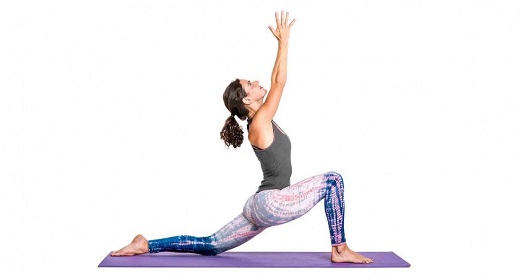by Ben Owens: Anjaneyasana (AHN-jah-nay-AHS-uh-nuh), also known as the Lunge or Low Lunge pose…
is a basic lunge pose that is found in many yoga classes and routines, and is known to stretch the hips, gluteus muscles and quadriceps while improving balance, concentration and core awareness. During this exercise, make sure to maintain a focus on your breathing. We often forget to consciously focus on our breathing, taking full breathes throughout the entire exercise. Pay attention to how the Lunge Pose affects your breathing.
PHILOSOPHY AND ORIGIN:
The term Anjaneya is a matronymic reference to Lord Hanuman using his mother’s name, Anjani. Lord Hanuman is a central part of Hindu devotional worship, believed to be an incarnation of Lord Shiva, and is often portrayed as resembling a monkey. The pose resembles a young, divine child (Anjaneya), reaching towards the sky and the warmth of the Sun, captivated by a glowing fruit in the sky as depicted in the traditional epic.
SANSKRIT:
- Anjaneya: Lord Hanumān, divine entity of spiritual significance
- Asana: pose
TIPS:
This common pose stretches the core, hips, gluteus muscles and quadriceps. While this can help with relief from discomfort and prevent strain, exercise caution. Go slowly and don’t push your body beyond its limits.
LEVEL:
Beginner (1)
PHYSICAL BENEFITS:
- Strengthens the quadriceps and gluteus muscles
- Stretches the psoas and hips
- Relieves sciatica pain
- Expands your chest, lungs and shoulders
ENERGETIC BENEFITS:
- Develops stamina and endurance in your thighs
- Improves your balance, concentration and core awareness
- Calms the mind
MUDRA: JNANA MUDRA
We recommend incorporating the Jnana Mudra into your Lunge Pose as it is believed to be the gesture of wisdom, and has deep ties to the divine nature of this exercise. This mudra is most commonly used for meditation and literally translates to “wisdom sign” or “knowledge gesture.”
How to:
While in your asana, fold the index finger and until it touches the base of the thumb. The index forms a circle, but the thumb remains straight out. Gently straighten the other three fingers.
If you wish to practice the mudra before and/or after your exercise, you can continue the gesture through its full meditation routine by placing your hands (as described) on your knees with your palms downwards. Each hand’s three fingers should point forward and downwards. Relax your shoulders while keeping the spine straight, focusing on your technique during this meditation.
MANTRA:
Hanuman Mantra for Success
As this pose is a divine tie-in to Lord Hanuman, wisdom and the power of knowledge and the spirit, the Hanuman Mantra for Success is a perfect pairing for your exercise. Practice this mantra with your pose by repeating the following chant:
Marut nandan namo namah
Kasht bhanjan namo namah
Asur nikandan namo namah
Shri ram dhootam namo namah.
Translation:
I pay my obedience to “the Son of Wind God”, or Lord Hanumana.
I pay my obedience to Lord Hanumana, who is the destroyer of all kinds of sorrows
I pay my obedience to Lord Hanumana, who is the destroyer of asuras, or demons
I pay my obedience to Lord Hanumana, who is the messenger of Lord Rama
PREPARATORY POSES:
- Adho Mukha Svanasana
- Prasarita Padottanasana
- Supta Virasana
- Utkatasana
FOLLOW-UP POSES:
- Virabhadrasana I (Warrior Pose I)
- Virabhadrasana III (Warrior Pose III)
CONTRAINDICATIONS AND CAUTIONS:
This pose is a gentle, relaxing exercise, but you should still check with a doctor before performing the pose if you have any of the following conditions:
- High blood pressure
- Knee injuries
- Those with shoulder problems should not raise their arms above their head, instead placing their hands on their front thigh
- Those with neck or spinal injuries should not take the backbend outlined in Step 3, and should instead keep their eye gaze forwards or downwards
ADJUSTMENTS/MODIFICATIONS:
- Place a soft foam block or pillow under the back knee for cushioning
- Do not raise the arms overhead if you have a shoulder or back injury
- Keep the gaze downwards or forwards if you have a neck injury
- To challenge your balance, try this pose with the eyes closed
- To improve balance, complete this exercise while facing a wall, pressing your big toe of the front foot against the wall and stretching both arms upward, fingertips towards the wall
STEP-BY-STEP:
- Start in Downward-Facing Dog Pose (Adho Mukha Svanasana). On an exhalation, step your right foot forward and place it beside your right thumb, lining up your right knee over your right ankle. Lower your left knee to the floor, ensuring to place it behind your hips.
- On an inhalation, raise your torso and sweep your arms above your head with your palms facing one another, placing your biceps beside your ears. On your next exhale, allow your hips to settle forwards and down until you feel a stretch in the front of your left leg and psoas.
- Draw your tailbone done towards the earth, lengthening your lower back and engaging your core muscles. Begin to draw your thumbs into the back plane of your body as you reach up with your heart, and shift your gaze up for a mild backbend.
- Stay here, or raise your back knee off the mat for a full Crescent Lunge.
- To exit the pose, place your hands down on the mat and step back to Downward Facing Dog Pose (Adho Mukha Svanasana). Repeat with the left leg forwards.















































